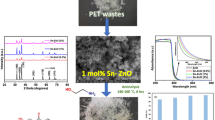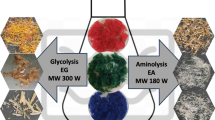Abstract
The high PET consume, mainly as bottles, associated with rapid disposal and high resistance to ambient conditions and biological degradation lead to accumulation in the enviromental, constituting a worrying scenario in world level. Chemical recycle PET by glycolysis is an important alternative, once bis(hydroxiethyl)terephthalate (BHET), high added value monomer, can be obtained. In this context, this study approaches the use of titanate nanotubes (i.e. sodium/protonated titanate nanotubes) as catalyst for PET glycolysis. Reactional conditions, the origin and granulometry of PET flakes were evaluated (at 196 °C). Best results (BHET yield > 80%) were obtained for both catalyst in 3 h of reaction. The protonated titanate nanotubes catalyst were more efficient than sodium titanate nanotubes due to greater concentration of Brönsted and Lewis acid sites, indicated by TPD analyzes.
Graphical Abstract










Similar content being viewed by others
References
Dang Y, Luo X, Wang F, Li Y (2016) Waste Manag 52:360–366
Sangalang A, Bartolome L, Kim DH (2015) Polym Degrad Stab 115:45–53
ABIPET (2013) Indústria do PET no Brasil: Mercados, perspectivas e reciclagem (Panorama 2013). http://www.abipet.org.br/index.html?method=mostrarInstitucional&id=36. Accessed 23 Aug 2018
ABRELPE (2014) Panorama dos Resíduos Sólidos No Brasil. http://www.abrelpe.org.br/panorama_apresentacao.cfm. Accessed 22 Aug 2018
ABRELPE (2015–2016) Panorama dos Resíduos Sólidos no Brasil. http://www.abrelpe.org.br/panorama_apresentacao.cfm. Accessed 22 Aug 2018
ABIPET (2014) Censo da Reciclagem de PET no Brasil – 10a Edição. http://www.abipet.org.br/index.html?method=mostrarDownloads&categoria.id=3. Accessed 4 Sept 2018
CEMPRE (2016) Ciclosoft—2016. http://cempre.org.br/ciclosoft/id/8. Accessed 4 Sept 2018
Wang H, Liu Y, Li Z et al (2009) Glycolysis of poly(ethylene terephthalate) catalyzed by ionic liquids. Eur Polym J 45:1535–1544. https://doi.org/10.1016/j.eurpolymj.2009.01.025
Imran M, Kim DH, Al-Masry WA et al (2013) Manganese-, cobalt-, and zinc-based mixed-oxide spinels as novel catalysts for the chemical recycling of poly(ethylene terephthalate) via glycolysis. Polym Degrad Stab 98:904–915. https://doi.org/10.1016/j.polymdegradstab.2013.01.007
Viana ME, Riul A, Carvalho GM et al (2011) Chemical recycling of PET by catalyzed glycolysis: kinetics of the heterogeneous reaction. Chem Eng J 173:210–219. https://doi.org/10.1016/j.cej.2011.07.031
Fang P, Liu B, Xu J et al (2018) High-efficiency glycolysis of poly(ethylene terephthalate) by sandwich-structure polyoxometalate catalyst with two active sites. Polym Degrad Stab 156:22–31. https://doi.org/10.1016/j.polymdegradstab.2018.07.004
Shukla SR, Kulkarni KS (2002) Depolymerization of poly(ethylene terephthalate) waste. J Appl Polym Sci 85:1765–1770. https://doi.org/10.1002/app.10714
López-Fonseca R, Duque-Ingunza I, de Rivas B et al (2010) Chemical recycling of post-consumer PET wastes by glycolysis in the presence of metal salts. Polym Degrad Stab 95:1022–1028. https://doi.org/10.1016/j.polymdegradstab.2010.03.007
Manjunathan P, Marakatti VS, Chandra P et al (2018) Mesoporous tin oxide: an efficient catalyst with versatile applications in acid and oxidation catalysis. Catal Today 309:61–76. https://doi.org/10.1016/j.cattod.2017.10.009
Masteri-Farahani M, Mirshekar S (2018) Covalent functionalization of graphene oxide with molybdenum-carboxylate complexes: new reusable catalysts for the epoxidation of olefins. Colloids Surfaces A Physicochem Eng Asp 538:387–392. https://doi.org/10.1016/j.colsurfa.2017.11.025
Abou Khalil T, Boujday S, Blanchard J, Bergaoui L (2018) Characterization and catalytic activity of Mn(salen) supported on a silica/clay-mineral composite: influence of the complex/support interaction on the catalytic efficiency. Chem Afr 1–11. https://doi.org/10.1007/s42250-018-0023-7
Akiyama S, Miyaji A, Hayashi Y et al (2018) Selective conversion of ethanol to 1,3-butadiene using germanium talc as catalyst. J Catal 359:184–197. https://doi.org/10.1016/j.jcat.2018.01.001
Zhu M, Li S, Li Z et al (2012) Investigation of solid catalysts for glycolysis of polyethylene terephthalate. Chem Eng J 185–186:168–177. https://doi.org/10.1016/j.cej.2012.01.068
Eshaq G, Elmetwally AE (2016) Mg–Zn–Al layered double hydroxide as a regenerable catalyst for the catalytic glycolysis of polyethylene terephthalate. J Mol Liq 214:1–6. https://doi.org/10.1016/j.molliq.2015.11.049
Kaur M, Malhotra R, Ali A (2018) Tungsten supported Ti/SiO2 nanoflowers as reusable heterogeneous catalyst for biodiesel production. Renew Energy 116:109–119. https://doi.org/10.1016/j.renene.2017.09.065
Lin YF, Huang KW, Ko BT, Lin KYA (2017) Bifunctional ZIF-78 heterogeneous catalyst with dual Lewis acidic and basic sites for carbon dioxide fixation via cyclic carbonate synthesis. J CO2 Util 22:178–183. https://doi.org/10.1016/j.jcou.2017.10.005
Sun Y, Cao C, Wei F et al (2016) Nanocarbon-based TEMPO as stable heterogeneous catalysts for partial oxidation of alcohols. Sci Bull 61:772–777. https://doi.org/10.1007/s11434-016-1070-6
Guo Z, Lindqvist K, de la Motte H (2018) An efficient recycling process of glycolysis of PET in the presence of a sustainable nanocatalyst. J Appl Polym Sci 135:6–11. https://doi.org/10.1002/app.46285
Bartolome L, Imran M, Lee KG et al (2014) Superparamagnetic γ-Fe2O3 nanoparticles as an easily recoverable catalyst for the chemical recycling of PET. Green Chem 16:279–286. https://doi.org/10.1039/C3GC41834K
Sallem F, Chassagnon R, Megriche A et al (2017) Effect of mechanical stirring and temperature on dynamic hydrothermal synthesis of titanate nanotubes. J Alloys Compd 722:785–796. https://doi.org/10.1016/j.jallcom.2017.06.172
Monteiro WF, Santos CAB, Hoffmann MS et al (2018) Modified titanate nanotubes for the production of novel aliphatic polyurethane nanocomposites. Polym Compos 1–9. https://doi.org/10.1002/pc.25038
Camposeco R, Castillo S, Mejia-Centeno I et al (2016) Behavior of Lewis and Brönsted surface acidity featured by Ag, Au, Ce, La, Fe, Mn, Pd, Pt, V and W decorated on protonated titanate nanotubes. Microporous Mesoporous Mater 236:235–243. https://doi.org/10.1016/j.micromeso.2016.08.033
Monteiro WF, Vieira MO, Aquino AS et al (2017) CO2 conversion to propylene carbonate catalyzed by ionic liquid containing organosilane groups supported on titanate nanotubes/nanowires. Appl Catal A 544:46–54. https://doi.org/10.1016/j.apcata.2017.07.011
Coelho DC, Oliveira AC, Filho JM et al (2016) Effect of the active metal on the catalytic activity of the titanate nanotubes for dry reforming of methane. Chem Eng J 290:438–453. https://doi.org/10.1016/j.cej.2016.01.051
Hernández-Hipólito P, García-Castillejos M, Martínez-Klimova E et al (2014) Biodiesel production with nanotubular sodium titanate as a catalyst. Catal Today 220–222:4–11. https://doi.org/10.1557/adv.2015.52
de Carvalho DC, Oliveira AC, Ferreira OP et al (2017) Titanate nanotubes as acid catalysts for acetalization of glycerol with acetone: Influence of the synthesis time and the role of structure on the catalytic performance. Chem Eng J 313:1454–1467. https://doi.org/10.1016/j.cej.2016.11.047
Sluban M, Bogdan C, Parvulescu VI et al (2017) Protonated titanate nanotubes as solid acid catalyst for aldol condensation. J Catal 346:161–169. https://doi.org/10.1021/ja100435w
László B, Baán K, Varga E et al (2016) Photo-induced reactions in the CO2-methane system on titanate nanotubes modified with Au and Rh nanoparticles. Appl Catal B Environ 199:473–484. https://doi.org/10.1016/j.apcatb.2016.06.057
Aouadi I, Touati H, Tatibouët JM, Bergaoui L (2017) Titanate nanotubes as ethanol decomposition catalysts: effect of coupling photocatalysis with non-thermal plasma. J Photochem Photobiol A 346:485–492. https://doi.org/10.1016/j.jphotochem.2017.06.030
Kiatkittipong K, Assabumrungrat S (2017) A comparative study of sodium/hydrogen titanate nanotubes/nanoribbons on destruction of recalcitrant compounds and sedimentation. J Clean Prod 148:905–914. https://doi.org/10.1016/j.jclepro.2017.02.043
Lima GR, Monteiro WF, Ligabue R, Santana RMC (2017) Titanate nanotubes as new nanostructured catalyst for depolymerization of PET by glycolysis reaction. Mater Res 20:588–595. https://doi.org/10.1590/1980-5373-mr-2017-0645
Kasuga T, Hiramatsu M, Hoson A et al (1998) Formation of titanium oxide nanotube. Langmuir 14:3160–3163. https://doi.org/10.1021/la9713816
Monteiro WF, dos Santos CAB, Einloft S et al (2016) Preparation of modified titanate nanotubes and its application in polyurethane nanocomposites. Macromol Symp 368:93–97. https://doi.org/10.1002/masy.201500146
Al-Sabagh AM, Yehia FZ, Eissa AMF et al (2014) Cu- and Zn-acetate-containing ionic liquids as catalysts for the glycolysis of poly(ethylene terephthalate). Polym Degrad Stab 110:364–377. https://doi.org/10.1016/j.polymdegradstab.2014.10.005
Geng Y, Dong T, Fang P et al (2015) Fast and effective glycolysis of poly(ethylene terephthalate) catalyzed by polyoxometalate. Polym Degrad Stab 117:30–36. https://doi.org/10.1016/j.polymdegradstab.2015.03.019
Lin Q, Gu Y, Chen D (2013) Attapulgite-supported aluminum oxide hydroxide catalyst for synthesis of poly(ethylene terephthalate). J Appl Polym Sci 129:2571–2579. https://doi.org/10.1002/app.38973
López-Fonseca R, Duque-Ingunza I, de Rivas B et al (2011) Kinetics of catalytic glycolysis of PET wastes with sodium carbonate. Chem Eng J 168:312–320. https://doi.org/10.1016/j.cej.2011.01.031
Syariffuddeen AA, Norhafizah A, Salmiaton AA (2012) Glycolysis of poly (ethylene terephthalate) (PET) waste under conventional convection-conductive glycolysis. Int J Eng Res Technol 1:1–8
Rostamizadeh M, Jafarizad A, Gharibian S (2018) High efficient decolorization of Reactive Red 120 azo dye over reusable Fe-ZSM-5 nanocatalyst in electro-Fenton reaction. Sep Purif Technol 192:340–347. https://doi.org/10.1016/j.seppur.2017.10.041
Goje AS, Mishra S (2003) Chemical kinetics, simulation, and thermodynamics of glycolytic depolymerization of poly(ethylene terephthalate) waste with catalyst optimization for recycling of value added monomeric products. Macromol Mater Eng 288:326–336. https://doi.org/10.1002/mame.200390034
Yue QF, Wang CX, Zhang LN et al (2011) Glycolysis of poly(ethylene terephthalate) (PET) using basic ionic liquids as catalysts. Polym Degrad Stab 96:399–403. https://doi.org/10.1016/j.polymdegradstab.2010.12.020
Awaja F, Pavel D (2005) Recycling of PET. Eur Polym J 41:1453–1477. https://doi.org/10.1016/j.eurpolymj.2005.02.005
Chen CH (2003) Study of glycolysis of poly(ethylene terephthalate) recycled from postconsumer soft-drink bottles. III. Further investigation. J Appl Polym Sci 87:2004–2010. https://doi.org/10.1002/app.11694
Wang S, Wang C, Wang H et al (2015) Sodium titanium tris(glycolate) as a catalyst for the chemical recycling of poly(ethylene terephthalate) via glycolysis and repolycondensation. Polym Degrad Stab 114:105–114. https://doi.org/10.1016/j.polymdegradstab.2015.02.006
Tsai CC, Chen LC, Yeh TF, Teng H (2013) In situ Sn2+-incorporation synthesis of titanate nanotubes for photocatalytic dye degradation under visible light illumination. J Alloys Compd 546:95–101. https://doi.org/10.1016/j.jallcom.2012.08.081
Sim S, Cho EB, Chatterjee S (2016) H2 and CO2 uptake for hydrogen titanate (H2Ti3O7) nanotubes and nanorods at ambient temperature and pressure. Chem Eng J 303:64–72. https://doi.org/10.1016/j.cej.2016.05.099
Sandoval A, Hernández-Ventura C, Klimova TE (2017) Titanate nanotubes for removal of methylene blue dye by combined adsorption and photocatalysis. Fuel 198:22–30. https://doi.org/10.1016/j.fuel.2016.11.007
Santos SRA, Jardim IS, Bicalho HA et al (2016) Multifunctional catalysts based on carbon nanotubes and titanate nanotubes for oxidation of organic compounds in biphasic systems. J Colloid Interface Sci 483:211–219. https://doi.org/10.1016/j.jcis.2016.08.025
Viana BC, Ferreira OP, Filho AGS et al (2011) Alkali metal intercalated titanate nanotubes: a vibrational spectroscopy study. Vib Spectrosc 55:183–187. https://doi.org/10.1016/j.vibspec.2010.11.007
Gomes IS, de Carvalho DC, Oliveira AC et al (2018) On the reasons for deactivation of titanate nanotubes with metals catalysts in the acetalization of glycerol with acetone. Chem Eng J 334:1927–1942. https://doi.org/10.1016/j.cej.2017.11.112
Turki A, Kochkar H, Guillard C et al (2013) Effect of Na content and thermal treatment of titanate nanotubes on the photocatalytic degradation of formic acid. Appl Catal B Environ 138–139:401–415. https://doi.org/10.1016/j.apcatb.2013.03.020
Chen A, Zhao T, Gao H et al (2016) Titanate nanotube-promoted chemical fixation of carbon dioxide to cyclic carbonate: a combined experimental and computational study. Catal Sci Technol 6:780–790. https://doi.org/10.1039/C5CY01024A
Wang H, Yan R, Li Z et al (2010) Fe-containing magnetic ionic liquid as an effective catalyst for the glycolysis of poly(ethylene terephthalate). Catal Commun 11:763–767. https://doi.org/10.1016/j.catcom.2010.02.011
Acknowledgements
This study was financed in part by the Coordenação de Aperfeiçoamento de Pessoal de Nivel Superior – Brasil (CAPES) – Finance Code 001. The authors thank CNPq and CAPES by scholarships. PUCRS and UFRGS for technical support: the Laboratório Central de Microscopia e Microanálise (LabCEMM/PUCRS) by morphological analyzes, the Prof. Dr. Oscar W. Perez Lopez and the Laboratório de Processos Catalíticos (PROCAT/UFRGS) by TPD analyzes.
Author information
Authors and Affiliations
Corresponding author
Additional information
Publisher’s Note
Springer Nature remains neutral with regard to jurisdictional claims in published maps and institutional affiliations.
Electronic supplementary material
Below is the link to the electronic supplementary material.
Rights and permissions
About this article
Cite this article
Lima, G.R., Monteiro, W.F., Scheid, C.M. et al. Evaluation of Sodium/Protonated Titanate Nanotubes Catalysts in Virgin and Post Consumer PET Depolymerization. Catal Lett 149, 1415–1426 (2019). https://doi.org/10.1007/s10562-019-02724-8
Received:
Accepted:
Published:
Issue Date:
DOI: https://doi.org/10.1007/s10562-019-02724-8




